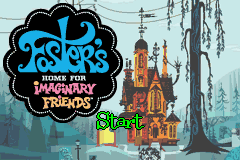Retro Replay Review
Gameplay
Foster’s Home for Imaginary Friends offers a charming blend of platforming, puzzle-solving, and light action that will feel instantly familiar to fans of the Cartoon Network series. Players alternate between controlling Mac and Bloo, each character boasting unique abilities that complement one another. Mac’s agility and careful problem‐solving skills pair nicely with Bloo’s mischievous speed, encouraging creative approaches to each level’s objectives.
(HEY YOU!! We hope you enjoy! We try not to run ads. So basically, this is a very expensive hobby running this site. Please consider joining us for updates, forums, and more. Network w/ us to make some cash or friends while retro gaming, and you can win some free retro games for posting. Okay, carry on 👍)
The game’s structure is mission‐based, drawing inspiration from classic episodes like “Go Goo Go” and “Store Wars.” Each stage tasks you with finding hidden items, guiding other imaginary friends to safety, or outwitting a hapless villain who’s invaded Foster’s Home. Objectives are clearly stated but often require creative thinking—pushing crates, activating switches, and timing jumps to progress—making sure younger players have a sense of accomplishment without feeling overwhelmed.
Exploration is encouraged through collectible tokens scattered around the sprawling mansion and its gardens. These tokens unlock bonus mini‐games and character artwork, adding replay value for completionists. While the difficulty curve is gentle—ideal for a family audience—more seasoned players will appreciate the optional side challenges that demand precision and patience. Overall, the gameplay loop is varied enough to prevent repetition, yet straightforward enough for newcomers.
Graphics
Visually, Foster’s Home for Imaginary Friends stays true to Craig McCracken’s distinctive art style. The game employs bright, saturated colors and bold outlines, giving characters and environments a hand‐drawn, cartoon‐like appeal. Whether you’re navigating the sunlit hallways or the shadowy attic, every screen pops with the same whimsical energy that made the TV series so memorable.
Character models for Mac, Bloo, Wilt, Eduardo, Coco, and more are faithfully recreated in 3D, complete with expressive facial animations. Each imaginary friend moves with fluidity—Bloo’s exaggerated prances and Wilt’s oversized strides feel especially on‐point. Backgrounds are richly detailed, featuring nods to series landmarks like the treehouse, art studio, and courtyard fountain.
Performance is stable on all supported platforms, with consistent frame rates and minimal load times between levels. Subtle lighting effects—like sunlight streaming through stained glass or the soft glow of a nightlight—enhance immersion without taxing hardware. Occasional texture pop-ins are rare and don’t detract from the overall presentation.
Story
The narrative framework of Foster’s Home for Imaginary Friends weaves together a series of mini‐adventures rather than a single, linear plot. Each mission is introduced by a brief cutscene or in‐game dialogue that ties back to iconic show moments, ensuring that long-time viewers get a strong sense of nostalgia. Newcomers are never left in the dark, as friendly tutorials and NPC greetings smoothly explain each character’s motivations.
Dialogue is peppered with the series’ trademark humor, courtesy of Bloo’s cheeky one-liners and Mac’s earnest encouragement. Secondary characters like Frankie, Madame Foster, and Mr. Herriman make cameo appearances, lending their voices (or witty text captions) to side quests that expand on minor show details. The result is a light, episodic tone that never takes itself too seriously.
Although the game doesn’t endeavor to tell a sweeping epic, its pacing is well-judged. Short bursts of platforming action are balanced by quieter moments of exploration and character interaction. For younger players, this variety prevents fatigue, while fans will appreciate the clever callbacks to beloved episodes—such as retrieving Goo’s inventions or calming down Eduardo’s temper tantrums.
Overall Experience
Foster’s Home for Imaginary Friends succeeds as both a love letter to fans and an accessible adventure for newcomers. Its blend of character‐swapping gameplay, vibrant visuals, and bite-sized storytelling ensures that few play sessions feel long or repetitive. Each return trip to the mansion reveals new nooks to explore and hidden challenges to conquer.
While seasoned platformer enthusiasts might find the difficulty on the easier side, the game’s charm and variety keep it engaging. The absence of punishing checkpoints means younger players can learn through trial and error, making it an ideal family title. Adults who grew up watching the show will find themselves smiling at tiny references, from the kitchen’s huge cookie jar to Coco’s random egg-cracking antics.
In the end, Foster’s Home for Imaginary Friends offers a wholesome, lighthearted experience that captures the spirit of the Cartoon Network hit. Its colorful world, faithful character portrayals, and thoughtful level design make it a solid pick for anyone seeking a gentle, nostalgia-driven platformer. Whether you’re guiding Bloo through booby-trapped corridors or helping Mac solve another quirky puzzle, this game invites you to rediscover the magic of imaginary friendship.
 Retro Replay Retro Replay gaming reviews, news, emulation, geek stuff and more!
Retro Replay Retro Replay gaming reviews, news, emulation, geek stuff and more!









Reviews
There are no reviews yet.